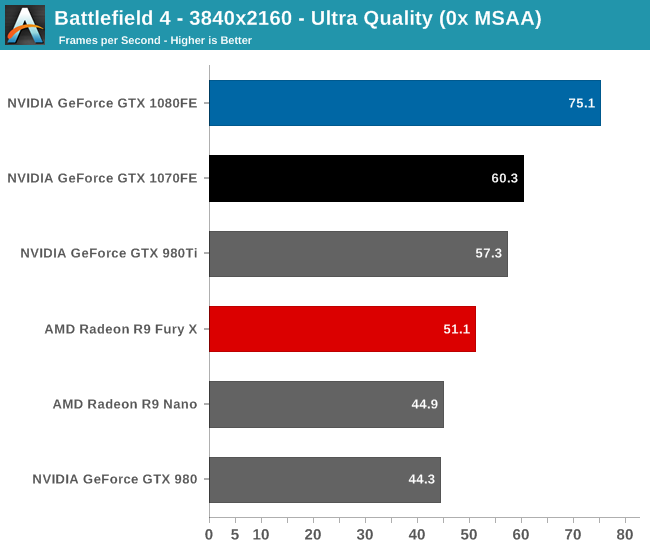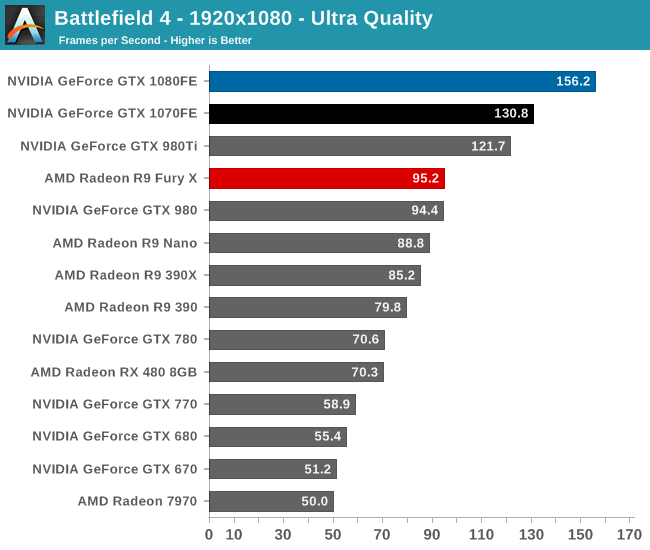The NVIDIA GeForce GTX 1080 & GTX 1070 Founders Editions Review: Kicking Off the FinFET Generation
by Ryan Smith on July 20, 2016 8:45 AM ESTBattlefield 4
One of the older games in our benchmark suite, DICE’s Battlefield 4 remains a staple of MP gaming. Even at its age, Battlefield 4 remained a challenging game in its own right, as very few mass market MP shooters push the envelope on graphics quality right now. As these benchmarks are from single player mode, based on our experiences our rule of thumb here is that multiplayer framerates will dip to half our single player framerates, which means a card needs to be able to average at least 60fps if it’s to be able to hold up in multiplayer.



As a game that has traditionally favored NVIDIA, Battlefield 4 makes for a very clean sweep of the field. The GTX 1080 takes top honors with the GTX 1070 some distance behind it. Notably, the two Pascal cards become the first cards to cross 60fps at 4K, which means that they’re the first cards we can be reasonably sure won’t have framerate dips below 30fps in multiplayer.
Looking at our standard generational comparisons, both GTX 1080 and GTX 1070 improve upon their predecessors by about what we’d expect; 67% and 58% respectively. Or to see how GTX 1080 and GTX 1070 compare, we find that the GTX 1080 leads its cut-down sibling by between 20% and 25%, with the gap increasing with the resolution. This is consistent with what we know about GTX 1080, as its bandwidth advantage means that it’s going to have an easier time pushing pixels at 4K, as the case is here.
Finally, to check in on the GTX 680, we find the GTX 1080 has only improved in performance by 2.8x, which is actually a bit less of a gain than the average. None the less we’ve gone from a card that can’t quite muster 1080p with 4xMSAA to a card that can easily handle 4K without any MSAA.










200 Comments
View All Comments
Ninhalem - Wednesday, July 20, 2016 - link
There's 32 freaking pages in this review. Maybe people have other jobs instead of writing all day long. Did you ever think of that?I'll take quality and a long publishing time over crap and rushing out the door.
Stuka87 - Wednesday, July 20, 2016 - link
Thanks for the extremely in depth review Ryan!cknobman - Wednesday, July 20, 2016 - link
I cannot help feel just a bit underwhelmed.Of course these Nvidia cards kick some major butt in games that have always favored Nvidia but I noticed that in games not specifically coded to take advantage of Nvidia and furthermore games with DX12 that these cards performance advantage is minimal at best vs an old Fury X with half the video RAM.
Then when you take into account Vulcan API and newer DX12 games (which can be found elsewhere) you see that the prices for these cards is a tad ridiculous and the performance advantage starts to melt away.
I am waiting for AMD to release their next "big gun" before I make a purchase decision.
I'm rocking a 4k monitor right now and 60fps at that resolution is my target.
nathanddrews - Wednesday, July 20, 2016 - link
1080 is close to being that 4K60 card, but can't quite cut it. I'm waiting for "Big Vega" vs 1080Ti before dropping any money.lefty2 - Wednesday, July 20, 2016 - link
Great review - one of the few that highlights the fact the Pascal async compute is only half as good as AMD's version. Async compute is a key feature for increasing performance in DX12 and Vulkan and that's going to allow the RX 480 to perform well against the GTX 1060Daniel Egger - Wednesday, July 20, 2016 - link
"... why the memory controller organization of GP104 is 8x32b instead of 4x64b like GM204"Sounds like it's the other way around.
Ryan Smith - Wednesday, July 20, 2016 - link
No, that's correct. 8 32bit wide controllers rather than 4 64bit wide controllers.http://images.anandtech.com/doci/10325/GeForce_GTX...
http://images.anandtech.com/doci/8526/GeForce_GTX_...
DominionSeraph - Wednesday, July 20, 2016 - link
>It has taken about 2 years longer than we’d normally see... for a review of a flagship card to come out
sgeocla - Wednesday, July 20, 2016 - link
The old Maxwell was so optimized it was always full and didn't even need Async Compute. The new Pascal is so much more optimized that it even has time to create the "holes" in execution (not counting the ones in your pocket) that were "missing" in the old architecture to be able to benefit for Async Compute. Expect Volta to create even more holes (with hardware support) for Async Compute to fill.tipoo - Wednesday, July 20, 2016 - link
That's demonstrably untrue.http://www.futuremark.com/pressreleases/a-closer-l...
Plenty of holes that could have been filled in Maxwell.